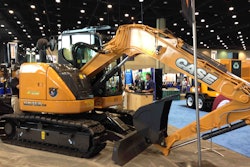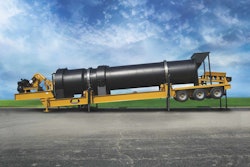![DBR_BR_1From BB[1]](https://img.equipmentworld.com/files/base/randallreilly/all/image/2013/12/eqw.DBR_BR_1From-BB1.png?auto=format%2Ccompress&fit=max&q=70&w=400)
Great ideas don’t always have to born in the moment or generated by a mainframe super computer. Sometimes it is as simple as looking back to what has performed well in the past and continues to do so in the present. Such is the case for dowel bar retrofit (DBR).
DBR is a load transfer restoration technique that restores load carrying capacity to working joints and cracks in otherwise structurally sound concrete. The process involves placement of steel dowel bars across concrete pavement joints and/or cracks that exhibit poor load transfer.
DBR has been used extensively in the US for over 20 years on interstate highways, secondary roads and city streets with more than 6.5 million bars installed to date.
Looking Back
The mid-20th century saw a boom in interstate highway construction, but within a short time it became clear that the traffic projections by the engineers of the day were woefully underestimated with many concrete pavements exceeding their design lives in less than a decade. This under-design led to a number of performance issues with Portland Cement Concrete Pavement (PCCP) facilitating the need for some well deserved repair and maintenance.
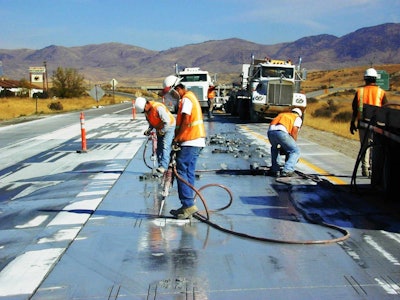
These faults, if left untreated, would cause a rough and noisy ride and eventually lead to cracked and damaged slabs. The Georgia Department of Transportation (GDOT) along with the industry had been credited with the development of the CPR tool box in the early 1970s, but joint faulting still plagued the industry as late as 1982. At this point in time, GDOT began experimenting with various load transfer devices and began adding dowel bars at slab joints as a standard design detail for new PCC pavements in response to tests that were being performed on new interstate construction projects.
In 1982, GDOT began testing the effectiveness of installing dowel bars across joints and cracks in existing JPCP as a retrofit load transfer device.
The first high production, large scale DBR project was constructed in 1992 by the Washington State Department of Transportation (WSDOT). This project utilized specially designed machines that allowed for the placement of hundreds, even thousands, of DBRs in a single day making it a cost effective and viable preservation treatment.
DBR is a flexible and economical repair method because it only has to be applied to the lanes that show distress. It is sustainable due to the fact that existing concrete pavements are rehabilitated rather than reconstructed and it saves materials compared to asphalt overlays. Often work can be performed entirely during off-peak hours, reducing inconvenience to motorists. DBR also permits a shorter timeline for many jobs. Most important, DBR results in a smooth, safe, long-lasting roadway repair.
In 2012, the industry officially celebrated the 30th anniversary of this successful retrofitting technique. Many states have now completed projects in which DBR was used as part of their CPR efforts. As we head into the future, what have we learned? What do data from the existing projects tell us and where do we go from here?
DBR Case Studies
Washington
The longest-standing data is from the state of Washington. By 1992, WSDOT was faced with a significant number pavements that had developed transverse joint faulting, many with average faulting greater than 1/2 inch.
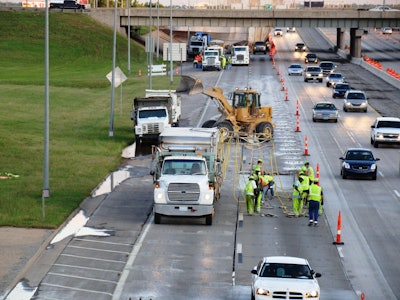
Since then, WSDOT has dowel bar retrofitted more than 626 lane miles or approximately 1,322,000 bars of faulted concrete pavements.
Roughness and wear was later examined on Washington state pavements which had been repaired with the DBR method between 1993 and 2007. Research was conducted by Linda M. Pierce, senior engineer of Applied Pavement Technology, Inc., as well as Stephen T. Muench, assistant professor, and Joe P. Mahoney, professor, both of the University of Washington.
The average age of the existing pavements prior to DBR was 32 years (with a range of 17 to 46 years), and the average in-service age of the DBR was 9 years (with a range of 1 to 14 years). Based upon the review of approximately 380,000 DBR slots, DBR application, in conjunction with panel replacements and diamond grinding, was found to be an effective rehabilitation treatment for faulted concrete pavements.
“From the review of data collected, it was determined that Washington state has experienced very little DBR slot-related distress, with less than 3 percent of all DBR slot distress combined on any given project and typically less than 1 percent on all projects,” says Pierce.
The best long-term DBR performance is associated with projects that have been repaired before the occurrence of significant faulting.
According to Jeff Uhlmeyer, state pavement engineer with WSDOT, “WSDOT has had the best success when we provided DBR when faulting was only 1/8 to 1/4 inch. Faulting caught at this early level, before it gets too severe, will provide a longer pavement life — 15 years or more. As faulting increases, to around 1/2 inch or more, that’s when your pavement life decreases in some cases to 10 years.”
The International Grinding & Grooving Association (IGGA) recommends considering DBR for pavements that exhibit load transfer below 60 percent. Pavements that exhibit extreme cracking or deterioration at joints warrant further investigation to see if structural enhancements are necessary.
North Dakota
North Dakota performed its first DBR in 1995. That year, five miles of pavement along a stretch of I-29 between Fargo and North Dakota’s southern border were retrofitted; another 22 miles were constructed the following year.
![DBR_BR_1From BB[1]](https://img.equipmentworld.com/files/base/randallreilly/all/image/2013/12/eqw.DBR_BR_1From-BB1.png?auto=format%2Ccompress&fit=max&q=70&w=400)
Traffic was habitually shifting to the passing lane to avoid the faults, says Kevin Gorder, assistant district engineer of the Fargo District with the North Dakota Department of Transportation (NDDOT).
Concrete Pavement Rehabilitation that included DBR and diamond grinding was completed on the surfaces, and has kept these roads, now almost 40 years old, in good condition.
“That pavement is still in service,” says Gorder. “Since then we have done more projects. I would estimate that we’ve done 130 miles of DBR in my district.”
Gorder works in District 8, in the southeast corner of the state, and some of those retrofitted miles are on I-94 in Fargo.
“Those roads have traffic counts in the mid to upper 60,000 range [Average Annual Daily Traffic], with 5,000 trucks. The work was done in 2003, and the roads are still in good shape.”
A section of I-29 between State Highway 200 East and 200 West underwent complete pavement restoration in 1999.
The pre-rehabilitation conditions of the roadway included transverse joint faulting that ranged from 1/4- to 3/8-inch in the truck lane and little to no faulting in the passing lane, with a few isolated areas that contained broken and dropped panels.
The NDDOT decided to target only the most deteriorated sections of the pavement, thereby stretching their dollars for more miles. Smoothness measurements taken approximately ten years after the project was completed showed an International Roughness Index (IRI) of 62 inches per mile. In contrast, the left lane, which did not utilize DBR to restore load transfer, had an IRI of 140 inches per mile. This contrast demonstrates the effectiveness of DBR in restoring sustained load transfer.
South Dakota
Interstate highway I-29 also benefited from DBR over the state line into South Dakota; here, too, the existing pavement had experienced faulting between panels, making the ride objectionable, according to Darin Hodges, concrete engineer with the South Dakota Department of Transportation (SDDOT).
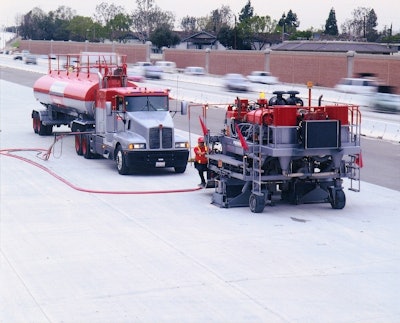
The Department completed DBR on I-90 near the town of Spearfish during the same time period. Spearfish is located near the western border that South Dakota shares with Wyoming.
“We also did DBR on two lane roads, one being South Dakota Highway 34.” South Dakota Highway 34 is a state route that extends east-west across the state, parallel to Interstate 90.
“All of those projects have been out there for ten years – some almost 20,” says Hodges. “DBR, combined with diamond grinding, fixed the faulting for the rest of the pavement life.”
US 212 is another east-west, two-lane concrete roadway that extends across the entire state of South Dakota, crossing through Watertown in the Northeast part of the state.
Constructed in 1984, a section of pavement located between Watertown and SD 15 was experiencing faulting of up to 3/4 inch by October of 2001. More than 16 miles of pavement received grinding, joint sealing, dowel bar retrofit (DBR) and profile correction.
“Because this CPR project was done at the right time, this initial 1984 project construction should last its full life expectancy of 40 years or more,” says Larry Engbrecht, executive vice president of the South Dakota Chapter of the American Concrete Pavement Association.
South Dakota continues to employ DBR for ongoing CPR efforts on both highways as well as secondary and municipal roadways.
Oklahoma
Numerous DBR projects have been completed in the Oklahoma City metro area. Projects in central Oklahoma involved Interstates 40, 35 and 44, with the majority being on I-44, according to Tom Hubbard, Field Division 4 resident engineer with the Oklahoma Department of Transportation (OKDOT).
Interstate 44 in Oklahoma is a highway that runs from the state’s southern border with Texas to the Missouri border in the northeast corner of the state. By 2004, pavement on I-44 was demonstrating transverse and longitudinal joint faulting.
To determine areas that were most in need of repair, explains Hubbard, “pavement replacement areas were quantified using a vehicle mounted digital image collection system.”
DBR, diamond grinding, joint sealing, selective panel replacement and base repair were used on the Oklahoma projects, and Hubbard notes that all work was completed during night-time hours.
Work on I-44 wrapped up in late 2009. At the time of project completion, 10 to 15 years of life expectancy was anticipated and to date no failures have been documented on I-44.
Minnesota
In 2000, officials in Olmsted County, Minnesota sought to repair a six mile section of the two-lane County State-Aid Highway (CSAH) 25, from CSAH 3 to CSAH 22 – a total of 5.34 miles.
Built in 1982, the pavement joints were faulting and the shoulders had started to settle. Random cracking was also occurring. Olmsted County decided on a concrete pavement preservation option including DBR, diamond grinding, partial and full-depth patching and joint re-sealing in order to obtain a longer- term solution.
According to Mike Sheehan, Olmsted County engineer, “DBR and the complete CPR process have held up very well since it was completed in 2000.”
He expects the road to last at least 15 years from when it first had corrective work completed.
Conclusion
States that have experience with DBR as part of their CPR program are committed to it as a repair option. It has proved to be long-lasting, with some states citing almost 20 years of service life so far and with the roads still in good condition.
Used in conjunction with other CPR practices such as diamond grinding, DBR can return a concrete roadway to a structurally sound, smooth condition that can exceed the smoothness and noise values attained at the time of construction.
For more information see the IGGA publication “Dowel Bar Retrofit – Do’s and Don’ts.
About IGGA: The International Grooving & Grinding Association (IGGA) is a non-profit trade association founded in 1972 by a group of dedicated industry professionals committed to the development of the diamond grinding and grooving process for surfaces constructed with Portland cement concrete and asphalt. In 1995, the IGGA joined in affiliation with the American Concrete Pavement Association (ACPA) and in 2012 formed the IGGA/ACPA Concrete Pavement Preservation Partnership (IGGA/ACPA CP3). Today this partnership serves as the technical resource and industry leader in the marketing of optimized pavement surfaces, concrete pavement restoration and pavement preservation around the world. The mission of the IGGA is to serve as the leading technical and promotional resource for the acceptance and proper use of diamond grinding and grooving as well as PCC preservation and restoration. For more information, visit igga.net.





